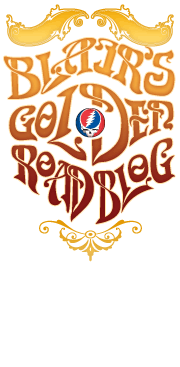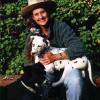The people came and listened/ Some of them came and played/ Others gave flowers away, yes they did/ Down in Monterey
—Eric Burdon & The Animals, 1967
Road trip! Could it really have been 17 years since Regan and I hit the highway for a weekend of concerts somewhere? It was such a part of our lives for so many years—Eugene, Santa Fe, Reno, Vegas, L.A., Irvine, Red Rocks, Telluride, Ventura, Sacramento. Yep, Sacramento ’94 was our last hurrah, and that year we brought our babysitter on the road with us to stay at the El Rancho motel (we called it the “El Rauncho” because the ol’ place had fallen into disrepair) to take care of our kids, then just seven months and 3, during the shows.
After Jerry died, we still hit nearly all the Bay Area shows by the various post-GD bands, but we never felt compelled to travel to go see RatDog or Phil & Friends and deal with sitters and hotels and all that. But the kids are older now—17 and 21—and Regan and I have been digging Furthur so much we thought it would be a gas to catch their two shows down at the Monterey County Fairgrounds, stay in a nice motel, get into that touring head space for a few days.
I vividly remember going to see the film Monterey Pop in New York City with my older brother and a friend right after it opened in January 1969. Living in the suburbs, there was no guarantee this “art film” was going to make it to our neck of the woods, and there was no way I was going to miss it. I was already a huge fan of the San Francisco bands that appeared in the film—the Airplane, Country Joe & the Fish and Big Brother with Janis—and the whole San Francisco/Summer of Love mythology still loomed large in my imagination, even though I had read that things had changed since that film had been shot. But seeing all those great bands (plus Jimi and Otis, etc.) and the beautiful hippie girls and the overall groovy vibe of the event as portrayed (and romanticized) in the film, had a powerful effect on me. And when I visited San Francisco with my family that summer of ’69, it was all over—I knew where my destiny lay.

poster for the fall tour.
So I was both thrilled and intrigued to finally make it to the Monterey Fairgrounds to see Phil and Bob’s first appearance there since June 18, 1967. Once the gates opened on Friday afternoon, we excitedly raced down a long walkway lined with dozens of craft booths and food concessions—a nice touch that added to the pleasing retro aspect of the weekend. However, as I turned a corner to enter the back of the cozy oval amphitheater, I was immediately struck by how shabby the place was. It looked as if it hadn’t seen a new coat of paint since 1967, and the entire floor of the arena was soft dirt/mud (it had rained midweek) covered with tons of wood shavings and sawdust—it was sort of like being in a giant hamster cage! Good for equestrian events, I guess. Disappointing aesthetics aside, the place did have an intimate feel, with its narrow covered grandstands and the high stage clearly visible from most spots in the venue (except behind the large sound booth about a third of the way back on the floor). We put our blanket down about 10 or 12 feet in front of the soundboard, dead center. The place filled slowly (a lot of folks came late from work or got stuck in traffic), and the pre-show mood was very upbeat.
I wish I could report that the Friday Furthur concert was the killer show of the year, but it was actually the weakest concert I’ve seen by this band. The first set was a motley affair. From the outset, it appeared that Bob was off his game. He was unsure of himself lyrically and both his pitch and timing were unsteady. “Two Djinn” was mostly a tuneless mess in the verses and “Mission in the Rain” not much better. The sound where we were should have been perfect, but it wasn’t—we could hear John K. cutting through only intermittently, and the overall balance seemed poor. Even so, “Pride of Cucamonga” and “Candyman” were both fairly well done, and I dug the set-ending “Quinn,” mostly for novelty’s sake. Considering the amazing song list folks at the Greek Theatre in L.A. had been treated to the previous night (for what turned out to be the Steve Jobs Memorial Show), it was a pretty disappointing set.
Unfortunately, Set Two had many of the same problems. It started out promisingly with a spry JK version of “Any Road” (a nice choice to end the week when HBO premiered its two-part Martin Scorsese documentary about the song’s author, George Harrison). But “Estimated” was a tad sluggish and the jam afterward positively leaden before it lurched clumsily into “Deal.” “Playing in the Band” was a vocal disaster and played at a glacial, uninspired pace. The “Dark Star” that followed was an improvement, but felt misplaced and somewhat forced.
Which brings up the Tyranny of the Set List. Now, I give major props to Furthur for continually coming up with imaginative and varied set lists. They’re supremely conscious about doling out big tunes and “special” songs at every stop, and most nights they deliver on the promising set list. But on a night like this one, when the band was struggling and the transitions mostly clumsy or nonexistent, going through the prescribed set list seemed like a chore. Can you imagine Garcia, on a night when things were not going very well, suddenly launching into “Dark Star” because it’s the next tune on the list? No, and that was part of the beauty of no list — whim and vibe and a sensitivity to the moment played a large role in dictating the course of the set, as did their attempts to create graceful passages from one key to the next as another determining factor in song choices.
The hodgepodge of songs that followed “Dark Star” was uneven, as well, with a few strong numbers—particularly “King Solomon’s Marbles” and “Dear Prudence” (Weir’s best song of the evening)—but also more turgid jamming that went nowhere. Our little group walked back to the motel after the show wondering what the hell we’d just witnessed—could it really have been that bad?—but hopeful that Saturday night would bring a stronger show.
(I should note that I listened to a recording of the show on archive.org a couple of days later and it did sound considerably better to me. The guitar was loud enough and the mix in general more normal. But Weir was still “off,” there was little continuity between songs and the jamming was often aimless.)
We spent a glorious sunny Saturday morning and early afternoon eating like kings and soaking in golden rays of California sunshine on a beach in nearby Carmel. Now, that’s livin’! Because of the sound issues we had at the Friday show (not to mention the distracting hordes of beer-swilling folks constantly passing through our area), we decided to dance in the side grandstand for Night Two. We snagged seats in the front row, pretty close to the stage on the JK side, and prayed that the sound would be good there.
about an hour before show time. If you look closely,
you can see the wood shavings covering the dirt floor.
Photo: Regan McMahon.
And it was! From the first moments of the opening “Feel Like a Stranger,” it was like seeing a different band. The sound was just about perfect where we were, JK was assertive from the get-go and Bob was confident and in control. I have seen many a Dead show marred by the crazy energy of distracted Saturday night crowds, but when JK went into a loping “Althea” second song of the first set, everyone was right there with him, hanging on every word. John has developed a special vocal rapport with Sunshine Becker that really elevated “No More Do I” (one of my favorite post-Dead originals) and, especially, the rare first-set “Comes a Time,” which was filled with passion and soared in a way that no song had the previous night. “Viola Lee Blues” felt like a fond nod to the Dead’s appearance in Monterey 44 years earlier, and the potent set-ending “Throwing Stones” seemed as pointedly topical in today’s political climate as it did when it was introduced nearly two decades ago.
The second set was filled with one highlight after another. I know there are those who think “The Golden Road” is lightweight fluff, but I’ve loved every version I’ve seen, and it always gets the crowd movin’. “Shakedown Street” kept the party going with its big, funktacular groove, and then it was on to a solid “Truckin’” (with nary a lyric flub!) and a healthy closing jam that eventually ended up (though not very smoothly) at “Let It Grow.” “Watchtower” was another nice surprise (to me, anyway), and that led to what I felt was the strongest song of the two nights—a spectacular “Morning Dew” that John sang with tremendous power and absolute commitment. His playing on the song was spot-on, too, and his high-speed “fanning” at the end of the final buildup was so stirring, it filled my heart with joy. The crowd was as quiet and respectful as can be, its connection to the music palpable.
Everything after that was gravy. The thundering ovation for the magnificent “Dew” was still swelling when the band leaped right into “Help on the Way”—also solid and sure-footed. But instead of the expected segue into “Franklin’s,” “Slipknot!” instead veered into a great version of “The Eleven” before finding its way back to a joyful “Franklin’s.” Everyone may have expected the “Saturday Night” encore, but looking around the old arena, all I saw was smiling faces and flailing bodies, dancing like there was no tomorrow. What a night!
Fun road trip. It will be interesting to see if the scattered reports of gate-crashing and unruly behavior by ticketless fans outside the arena and in the surrounding neighborhood before, during and after the concerts affect the band’s ability to return to Monterey. Why, it’s just like the bad old days of the late ’80s and early ’90s Dead scene all over again: “Wherever we go, the people all complain.”




